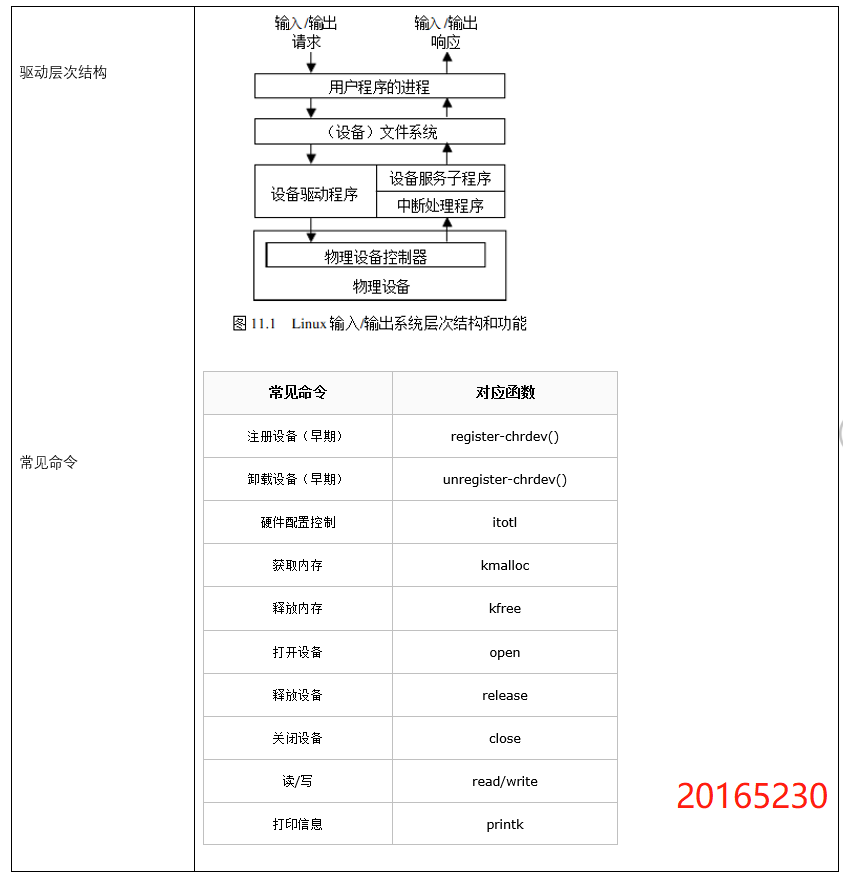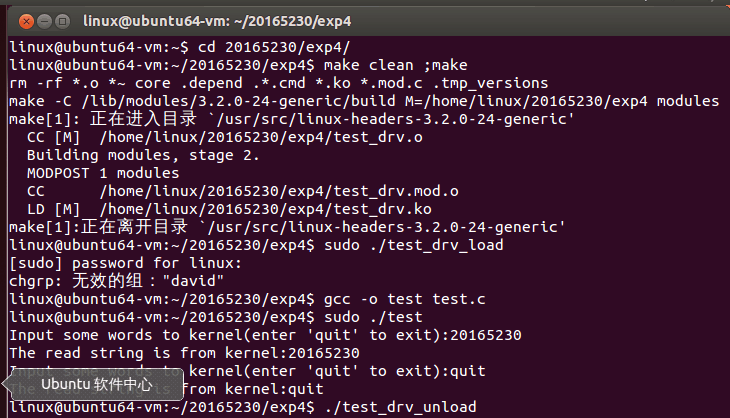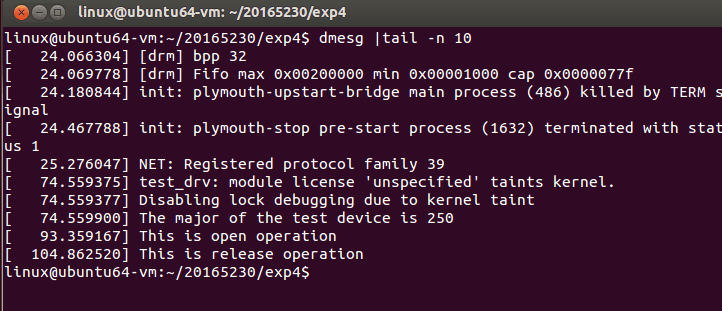2018-2019-1 20165230 实验四 外驱设备
实验内容
任务一
- 学习资源中全课中的“hqyj.嵌入式Linux应用程序开发标准教程.pdf”中的第十一章
- 提交康奈尔笔记的照片(可以多张)




任务二
- 在Ubuntu完成资源中全课中的“hqyj.嵌入式Linux应用程序开发标准教程.pdf”中的第十一章的test试验
- 提交编译,加载模块,卸载模块,测试运行的截图
实验知识点
- linux设备驱动
- 设备驱动与外界接口
- LCD设备驱动
- 块设备驱动
- test试验
实验步骤
1.编写代码(驱动程序的源代码如下
/* test_drv.c */
#include <linux/module.h>
#include <linux/init.h>
#include <linux/fs.h>
#include <linux/kernel.h>
#include <linux/slab.h>
#include <linux/types.h>
#include <linux/errno.h>
#include <linux/cdev.h>
#include <asm/uaccess.h>
#define TEST_DEVICE_NAME "test_dev"
#define BUFF_SZ 1024
/*全局变量*/
static struct cdev test_dev;
unsigned int major =0;
static char *data = NULL;
/*函数声明*/
static ssize_t test_read(struct file *file, char *buf, size_t count, loff_t *f_pos);
static ssize_t test_write(struct file *file,const char *buffer, size_t count,loff_t *f_pos);
static int test_open(struct inode *inode, struct file *file);
static int test_release(struct inode *inode,struct file *file);
/*读函数*/
static ssize_t test_read(struct file *file, char *buf, size_t count, loff_t *f_pos)
{
int len;
if (count < 0 )
{
return -EINVAL;
}
len = strlen(data);
count = (len > count)?count:len;
if (copy_to_user(buf, data, count))
{
return -EFAULT;
}
return count;
}
/*写函数*/
static ssize_t test_write(struct file *file, const char *buffer, size_t count, loff_t *f_pos)
{
if(count < 0)
{
return -EINVAL;
}
memset(data, 0, BUFF_SZ);
count = (BUFF_SZ > count)?count:BUFF_SZ;
if (copy_from_user(data, buffer, count))
{
return -EFAULT;
}
return count;
}
/*打开函数*/
static int test_open(struct inode *inode, struct file *file)
{
printk("This is open operation
");
data = (char*)kmalloc(sizeof(char) * BUFF_SZ, GFP_KERNEL);
if (!data)
{
return -ENOMEM;
}
memset(data, 0, BUFF_SZ);
return 0;
}
/*关闭函数*/
static int test_release(struct inode *inode,struct file *file)
{
printk("This is release operation
");
if (data)
{
kfree(data);
data = NULL;
}
return 0;
}
static void test_setup_cdev(struct cdev *dev, int minor,
struct file_operations *fops)
{
int err, devno = MKDEV(major, minor);
cdev_init(dev, fops);
dev->owner = THIS_MODULE;
dev->ops = fops;
err = cdev_add (dev, devno, 1);
if (err)
{
printk (KERN_NOTICE "Error %d adding test %d", err, minor);
}
}
/* tests设备的file_operations结构 */
static struct file_operations test_fops =
{
.owner = THIS_MODULE,
.read = test_read,
.write = test_write,
.open = test_open,
.release = test_release,
};
/*模块注册入口*/
int init_module(void)
{
int result;
dev_t dev = MKDEV(major, 0);
if (major)
{
result = register_chrdev_region(dev, 1, TEST_DEVICE_NAME);
}
else
{
result = alloc_chrdev_region(&dev, 0, 1, TEST_DEVICE_NAME);
major = MAJOR(dev);
}
if (result < 0)
{
printk(KERN_WARNING "Test device: unable to get major %d
", major);
return result;
}
test_setup_cdev(&test_dev, 0, &test_fops);
printk("The major of the test device is %d
", major);
return 0;
}
/*卸载模块*/
void cleanup_module(void)
{
cdev_del(&test_dev);
unregister_chrdev_region(MKDEV(major, 0), 1);
printk("Test device uninstalled
");
}
2.编译代码(编写Makefile如下)
KERNELDIR=/usr/src/4.4.0-101-generic
ifeq ($(KERNELRELEASE),)
KERNELDIR ?= /lib/modules/$(shell uname -r)/build
PWD := $(shell pwd)
modules:
$(MAKE) -C $(KERNELDIR) M=$(PWD) modules
modules_install:
$(MAKE) -C $(KERNELDIR) M=$(PWD) modules_install
clean:
rm -rf *.o *~ core .depend .*.cmd *.ko *.mod.c .tmp_versions
.PHONY: modules modules_install clean
else
obj-m := test_drv.o
endif
3.加载和卸载模块
- 加载模块:
/*test_drv_load*/
#!/bin/sh
# 驱动模块名称
module="test_drv"
# 设备名称。在/proc/devices中出现
device="test_dev"
# 设备文件的属性
mode="664"
group="david"
# 删除已存在的设备节点
rm -f /dev/${device}
# 加载驱动模块
/sbin/insmod -f ./$module.ko $* || exit 1
# 查到创建设备的主设备号
major=`cat /proc/devices | awk "\$2=="$device" {print \$1}"`
# 创建设备文件节点
mknod /dev/${device} c $major 0
# 设置设备文件属性
chgrp $group /dev/${device}
chmod $mode /dev/${device}
- 卸载模块
/*test_drv_unload*/
#!/bin/sh
module="test_drv"
device="test_dev"
# 卸载驱动模块
/sbin/rmmod $module $* || exit 1
# 删除设备文件
rm -f /dev/${device}
exit 0
4.编写测试代码,来测试驱动的运行是否正常。
/* test.c */
#include <stdio.h>
#include <stdlib.h>
#include <string.h>
#include <sys/stat.h>
#include <sys/types.h>
#include <unistd.h>
#include <fcntl.h>
#define TEST_DEVICE_FILENAME "/dev/test_dev" /* 设备文件名*/
#define BUFF_SZ 1024 /* 缓冲大小 */
int main()
{
int fd, nwrite, nread;
char buff[BUFF_SZ]; /*缓冲区*/
/* 打开设备文件 */
fd = open(TEST_DEVICE_FILENAME, O_RDWR);
if (fd < 0)
{
perror("open");
exit(1);
}
do
{
printf("Input some words to kernel(enter 'quit' to exit):");
memset(buff, 0, BUFF_SZ);
if (fgets(buff, BUFF_SZ, stdin) == NULL)
{
perror("fgets");
break;
}
buff[strlen(buff) - 1] = '�';
if (write(fd, buff, strlen(buff)) < 0) /* 向设备写入数据 */
{
perror("write");
break;
}
if (read(fd, buff, BUFF_SZ) < 0) /* 从设备读取数据 */
{
perror("read");
break;
}
else
{
printf("The read string is from kernel:%s
", buff);
}
} while(strncmp(buff, "quit", 4));
close(fd);
exit(0);
}
实验结果


实验中的问题及解决过程
- 问题一:用make命令编译Makefile 时出现Makefile:2: *** 遗漏分隔符 。 停止。

【错误的Makefile】
- 解决:gcc、rm、cp前面是tab分割符,不能用空格,否则会出现:
“makefile:2: *** 遗漏分隔符 。 停止。”这样的错误提示。
make中规定每一Shell命令之前的开头必须使用字符。
- 问题二:在自己的虚拟机上不能实现。
- 解决:发现是自己的虚拟机内核与实验所需的不同,换位实验一用到的老师的虚拟机,可以运行。